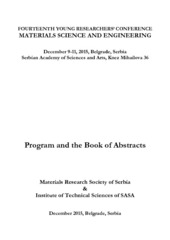Prikaz osnovnih podataka o dokumentu
Influence of PEO molecular weight on properties of ZnO/PEO composites
| dc.creator | Rajić, Vladimir B. | |
| dc.creator | Marković, Smilja | |
| dc.date.accessioned | 2017-06-10T15:45:07Z | |
| dc.date.issued | 2015 | |
| dc.identifier.uri | https://dais.sanu.ac.rs/123456789/838 | |
| dc.description.abstract | The removal of inorganic, organic and biological pollutants from drinking water and wastewater is one of the key steps in environmental protection. In recent 10 years a heterogeneous photocatalysis, as an efficient method for the degradation and mineralization of pollutants from water, has been widely studied and developed. For heterogeneous photocatalysis mostly used materials to initiate the photoreaction are oxide semiconductors such as TiO2 and ZnO. However, these oxide semiconductors, having band gap energies around 3.3 eV, can absorb UV light only. Since sunlight is a source of clean and cheap energy, where UV light makes no more than 3–5% of the total sunlight, it is highly desirable to modify the oxide semiconductor materials to be capable for visible light photocatalysts. Numerous approaches have been applied to modify the optical absorption properties and to improve the visible light photocatalytic activity including: (1) the incorporation of transition metal ions into the crystal structure, (2) sensitization of the particles’ surface, (3) hydrogenation, (4) the incorporation of crystalline defects in metal oxide semiconductors in the form of vacancies and interstitials, etc. Microwave processing is recognized as an attractive synthesis technique to introduce lattice defects. In this study ZnO spheroidal nanoparticles, synthesized by microwave processing, were used for preparation of composites with polyethylene oxide (PEO). The phase purity and crystal structure of the composites were investigated by X-ray diffraction (XRD) and Raman spectroscopy. The composites' particles morphology and size distributions were studied by FE–SEM and laser diffraction particle size analyzer, respectively. The optical properties were studied using UV–Vis diffuse reflectance and photoluminescence spectroscopy. It is found that ZnO and ZnO/PEO composites absorb about 50% of visible light, also red-shift of band gap energy (0.12-0.15 eV) compared to bulk ZnO was determined. The effect of PEO molecular weights, 200.000, 600.000 and 900.000 g/mol, on photocatalytic activity of ZnO/PEO composites were examined via degradation of methylene blue (MB) under direct sunlight irradiation. A large efficiency of MB degradation was found after 6 h of irradiation. The enhanced photocatalytic activity of ZnO/PEO composites is attributed to the: (1) lattice defects introduced in ZnO crystal structure by rapid microwave processing, and (2) presence of PEO as a source of oxygen interstitials. In order to confirm and further clarify the experimental results ab initio calculations based on density functional theory (DFT) were performed. | en |
| dc.format | (2015) 44-44 | |
| dc.format | application/pdf | |
| dc.language | en | |
| dc.publisher | Belgrade : Institute of Technical Sciences of SASA | |
| dc.relation | info:eu-repo/grantAgreement/MESTD/Integrated and Interdisciplinary Research (IIR or III)/45004/RS// | |
| dc.rights | openAccess | |
| dc.rights.uri | https://creativecommons.org/licenses/by-nc-nd/4.0/ | |
| dc.source | Program and the Book of Abstracts / Fourteenth Young Researchers' Conference Materials Sciences and Engineering, December 9-11, 2015, Belgrade, Serbia | en |
| dc.subject | heterogeneous photocatalysis | |
| dc.subject | water pollutants | |
| dc.subject | zinc oxide | |
| dc.subject | polyethylene oxide | |
| dc.title | Influence of PEO molecular weight on properties of ZnO/PEO composites | en |
| dc.type | conferenceObject | |
| dc.rights.license | BY-NC-ND | |
| dcterms.abstract | Рајић, Владимир; Марковић, Смиља; | |
| dc.citation.spage | 44 | |
| dc.citation.epage | 44 | |
| dc.type.version | publishedVersion | |
| dc.identifier.fulltext | https://dais.sanu.ac.rs/bitstream/id/21796/835.pdf | |
| dc.identifier.rcub | https://hdl.handle.net/21.15107/rcub_dais_838 |

